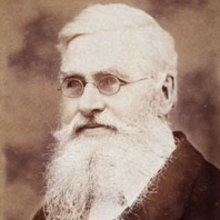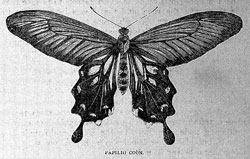Alfred Russel Wallace's legacy and the impact of biogeography on microbiology
Issue: Biogeography
27 August 2013 article

Alfred Russel Wallace was one of the 19th Century’s greatest field biologists, yet his scientific legacy is much farther reaching than it would first appear to the casual observer. A great supporter of Darwin throughout his life, following the co-discovery of natural selection, he studied biology in a much wider context, making seminal contributions to evolutionary biology, ecology and biogeography.
During his time in the Malay Archipelago, Alfred Russel Wallace observed many things regarding the distribution of macro-organisms, and how certain species were confined to specific regions – what he referred to as ‘the faunal discontinuity with geology’. Wallace had written as early as 1852 on the effects of geographical barriers on the distribution of primates in the Amazon Basin (Proc Zool Soc Lond 20, 107). Darwin himself mentions these works in Chapter 11 of On the Origin of Species in relation to his own words, ‘barriers of any kind or obstacles to free migration, are related in a close and important manner to the differences between the productions of various regions’, later in the chapter directly quoting Wallace’s 1855 paper from Annals & Magazine of Natural History (September, 1855) – ‘every species has come in to existence coincident both in space and time with a pre-existing closely allied species’. These works clearly show that Wallace was considering evolutionary theory in a biogeographical framework from an early stage in his studies.
Work on global diversity of bacteriophages, evolution of viruses, coevolution of viruses and parasites with their hosts, and emergence of novel pathogens all draw heavily on biogeography and the interaction of organisms with each other. These are exciting times to be a microbiologist…
The extensive fieldwork and other observations of Wallace during his time in the Amazon Basin and the Malay Archipelago on the distribution of species culminated in the publication of The Geographical Distribution of Animals (2 vols, London: Macmillan) in 1876. It is this and his other works that laid the foundations for the emergence of the branch of science we now refer to as biogeography – the study of the spatial (geographical) and temporal (geological) distribution of species. Wallace was also immortalised by Huxley, who coined the phrase ‘Wallace Line’ to describe the line dividing the islands that represent the change from Indian to Australian fauna within the Malay Archipelago, underlining the importance of Wallace as the father of biogeography.
Of course, in the mid-19th Century the existence of micro-organisms was known, but their fundamental importance was yet to be fully realised. The prevailing view was then, and until recently, that micro-organisms are distributed globally and can proliferate in any suitable habitat, with even Darwin stating in On the Origin of Species that ‘the lower any group of organisms is, the more widely it is apt to range’. This view was, of course, reinforced by the famous quote of Lourens Baas Becking of ‘everything is everywhere, but the environment selects’.

These views are now beginning to change and there is an increasing body of evidence that points to micro-organisms having a biogeography of their own. As we continue to further our understanding of the influence micro-organisms play within ecosystems, the importance of microbial biogeography will increase, such that we will gain a greater understanding of global localisation within global nutrient cycling, decomposition and recycling, autotrophic production and the search for novel biotechnology. Key to this is the defining of the microbial species, which has also attracted a lot of attention (see Staley, 2009, in Further reading). These concepts are well established in higher organisms or at least, less controversial, yet they operate at a different taxonomic resolution to those applied to micro-organisms such that, when viewed at the biogeographical level, details of distribution and the factors affecting microbial species may be masked.
It is, however, clear that technological advances in biology, such as affordable genome sequencing and molecular detection methods, are driving the study of microbial biogeography forward. Work carried out in Rachel Whitaker’s laboratory at the University of Illinois has built on the conventional evolutionary biologist’s viewpoint which states that new species arise when genetic exchange between populations is blocked, resulting in reproductive isolation, adaptation and emergence of a new species (allopatric speciation in technical terms). Using whole-genome sequences of the extremophile Sulfolobus islandicus, from widely separated populations in the USA and Russia, Whitaker has been able to study population divergence in isolation. In keeping with how island evolution crystallised Wallace’s thoughts, the isolation of S. islandicus in the hot springs it inhabits may also be thought of as analogous to island isolation, separating the strains from wider populations. Whitaker was able to show that in the case of S. islandicus, the physical and chemical processes within the hot springs it inhabits had relatively little effect on divergence.
Interestingly, the variation observed in the genomes of S. islandicus is mainly due to viruses that act as parasites and agents of genetic transfer and the viral resistance mechanisms encoded within the S. islandicus genome that help protect them from viral attack (such as CRISPR-cas and restriction-modification systems). This is a trend we see in our own work on the human pathogen Corynebacterium diphtheriae; however, the biogeographical trends are obscured due to emigration and immigration amongst human populations, resulting in transfer of strains between this most mobile of ecosystems – the human body.

This transfer of microbial species is an increasingly interesting concept in the world of microbial biogeography in terms of pathogen co-evolution with hosts. It has also been explored in the context of ectomycorrhizal fungi and how humans, moving plants with intact root systems, have transported these around the world, mainly for economic purposes. Anne Pringle’s laboratory have shown that over 200 ectomycorrhizal fungi have been transported around the world, with various outcomes in terms of their survival, such as inability to colonise, succession by local fungal species in the host plant, persistence in the host plant but strains not spreading to local plant species, persistence in the host plant and strains spreading to local plant species, and finally failure to persist in the original host plant yet spreading to local plant species. This work clearly emphasises how little we understand about the microhabitats and the fundamental constraints micro-organisms experience to successfully colonise a niche.
On a macrobial scale, we think of biogeography as islands and continents, and barriers to gene flow being rivers and mountain ranges, but on a microbial scale the barriers are much smaller. Again, these frameworks are intrinsically linked to speciation and understanding the species concept. We have already met allopatric speciation above, but a more controversial theory (at least in macrobial terms) is sympatric speciation, where species evolve from a common ancestor whilst inhabiting the same geographical region. The influence of horizontal gene transfer in microbial systems is clearly a potential driver of such processes, but perhaps the concept of microallopatric speciation is worth considering in a microbial setting. Many micro-organisms inhabit environments with complex spatial structures resulting in discrete microhabitats within a specific ecological niche, soil being a good example of this. Bulk sampling would suggest that species are sympatric (inhabiting the same niche), yet they may be constrained in a strict ecological microniche within that sample. It is this kind of situation where microallopatric speciation may explain evolution of microbial species, where limited gene flow can still occur, yet the organisms are largely partitioned within these microniches. Whilst microallopatric speciation was first considered in terms of macrobial species, where species inhabit discrete habitats in broadly overlapping ranges, it is a concept that fits nicely in a microbial setting and is similar to the concept of parapatric speciation, where adjacent populations diverge with limited gene flow.
Many groups have advanced our understanding of speciation and niche partitioning in terms of microbial biogeography, a particularly elegant story is that of Salinispora (see Paul R. Jensen’s article in this issue of Microbiology Today), yet we still have a long way to go. Work on global diversity of bacteriophages, evolution of viruses, co-evolution of viruses and parasites with their hosts, emergence of novel pathogens all draw heavily on biogeography and the interaction of organisms with each other. These are exciting times to be a microbiologist – I wonder what Wallace and Darwin would make of the diversity of micro-organisms we now know about, considering each was astounded by the diversity of animals and plants.
What is clear is that to explore the biogeography of microbial populations we need to clarify our microbial species concept and then start to place the spatial patterns of microbial evolution and diversity into a clear ecological and evolutionary framework with which we can gain insight in to all living things.
Paul A. Hoskisson
Strathclyde Institute of Pharmacy & Biomedical Sciences, University of Strathclyde. Email: [email protected].
Further reading
Martiny, J.B.H. & others (2006). Microbial biogeography: putting microorganisms on the map. Nature Rev Microbiol 4, 102–112.
Reno, M.L. & others (2009). Biogeography of the Sulfolobus islandicus pan-genome. Proc Natl Acad Sci U S A 106, 8605–8610.
Smith, C.H. & Beccaloni G. (editors) (2010). Natural Selection & Beyond; The Intellectual Legacy of Alfred Russel Wallace. Oxford: Oxford University Press.
Staley, J. (2009). The phylogenomic species concept. Microbiology Today 36, 80–83.
Vellinga, E.C., Wolfe, B.E. & Pringle, A. (2009). Global patterns of ectomycorrhizal introductions. New Phytologist 181, 960–973.
Image: Alfred Russel Wallace photographed in 1889. ‘Butterfly (Papilio coon)’ and ‘The sixth-shafted bird of paradise (Parotia sexpennis)’ illustrations taken from The Malay archipelago: the land of the orang-utan, and the bird of paradise by Alfred Russel Wallace. Wellcome Images, London..
